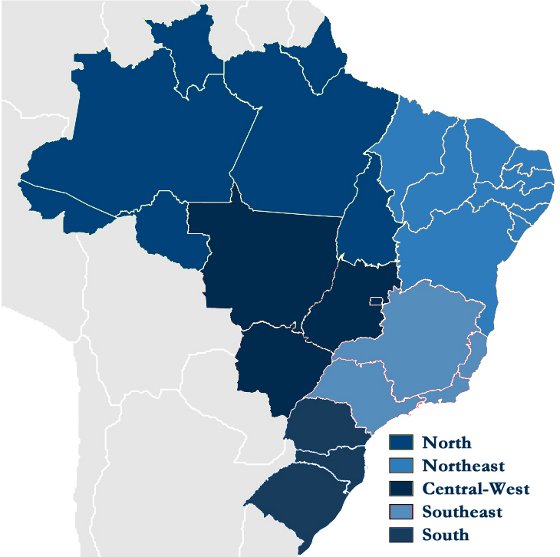The Five Regions of Brazil

Brazil is considered a country with continental proportions. It's the fifth largest country in the world and has a territorial extention of 8.514.712 km². Alone, it occupies 47% of Latin America and 1.7% of the world's land. Due to it's large size, the IBGE divides it into five regions: North, Center-West, Northeast, Southeast and South.
To group many states into one region, the IBGE uses many criteria, such as: similarity in human, physical, cultural, social and economic aspects. The division in regions has been utilized for a long time and has gone through many changes. The last version was established in 1970 and is used to this day. Each region has very peculiar characteristics. All of the miscegenation forms Brazil's great cultural and social diversity.
North
Formed by the states of Pará, Acre, Rondônia, Roraima, Amazonas, Tocantins and Amapá. It is located in the Amazon basin area, and the biggest forest in the world, the Amazon forest. With this, the ecosystem became its strong point, favoring ecotourism. The activities related to culture are also very valued. The main ones are the typical dances, such as the Círio de Nazaré and Festival de Parintins festivals. There's also the culinary arts with strong Indian influences, with dishes such as tucupi, manitoba and tacaca.
Northeast
The Northeast region has about 30% of the country's population. It's divided in nine states, where are: Pernambuco, Paraíba, Ceará, Rio Grande do Norte, Bahia, Sergipe, Alagoas, Maranhão and Piauí. The coastal cities are known for their natural beauty and for having a excellent attractions for tourism, including some of the best beaches in Brazil. The northeast region also has great cultural tourism owed mainly to the colonial cities such as Recife, Olinda and Salvador, among others. The culture is perhaps the main tourism draw of this region.
Popular genres such as Frevo, Xote, Xaxado, Baião, and Sambal, among others are said to have originated from this region. Northeast Brazil's cuisine's highlights include dishes like sarapatel, sururu, carne de sol, vatapá and acarajá. The major festivals are the Carnaval and São João.
Central-West
The Central-West region in Brazil is formed by the states of Mato Grosso, Mato Grosso do Sul, Goiás and the Federal District. There you can find the country's capital, Brasília. Its territory also covers the Complexo do Pantanal, which stands out for its beauty and for offering a great venue for ecotourism with various hotels and inns.
Besides the Pantanal, the city of Caldas Novas, in Goiás, has very interesting attractions: its thermal pools. In terms of culture, Central-West Brazil has cavalhadas, a spectacular depiction of medieval battles between Christians and Moors.
Southeast
The Southeast region is Brazil's urban and financial center. Formed by the states of São Paulo, Minas Gerais, Rio de Janeiro and Espírito Santo, the region is largely invested in the manufacturing, metallurgical and food industries. In relation to tourism, the region's highlights are its main cities.
Rio de Janeiro, for example, is known as the most beautiful city in Brazil and São Paulo as the biggest urban and gastronomic center. In Minas Gerais we can find the biggest number of historical cities in the country.
South
This region is composed by the states of Santa Catarina, Rio Grande do Sul and Paraná and its tourism draws are in its beaches, European colonies and it's climate with a harsher winter - different from the rest of the country. The culture of the south benefited from direct influences of the Germans and Italians.
Because of these infuences, all of the region's religious manifestations and festivals, dances and music are of European origins. It is a piece of Europe in Brazil. South Brazil's culinary highlights includes dishes such as the churrasco gaúcho, chimarrão, arroz com pinhão and barreado.
Brazil Travel Resources
Get reliable expedited Brazil visa service![]()
| |


